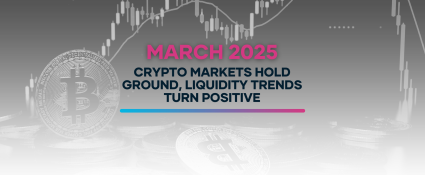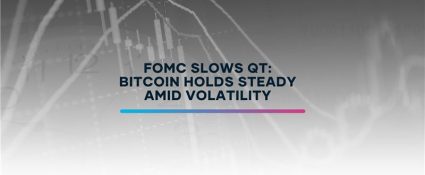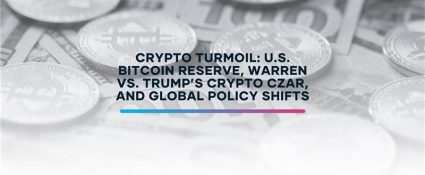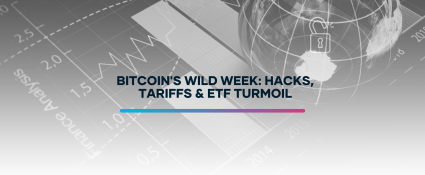This Week’s Recap
- Trump Unveils Double-Digit ‘Liberation Day’ Reciprocal Tariffs: Trump announced sweeping tariffs, including a 10% levy on all imports and higher rates on goods from China (34%), Taiwan (32%), India (26%), and the EU (20%), alongside a 25% tariff on foreign-made cars. The move, branded as “Liberation Day,” aims to boost U.S. manufacturing but raises concerns over inflation and trade tensions.
- FDIC Drops Crypto Pre-Approval Rule for Banks: The Federal Deposit Insurance Corporation (FDIC) announced that banks no longer need prior approval to engage in cryptocurrency-related activities, provided they manage associated risks appropriately. This reverses a previous policy requiring banks to obtain advance permission for such activities.
- Experts Call for Stablecoin Regulations in the US Before Implementing Crypto Tax Reforms: Prominent figures in the American cryptocurrency industry are urging for clear regulatory guidelines on stablecoins before introducing any tax reforms. They emphasize that the current uncertainty surrounding stablecoin classification and treatment under existing tax frameworks could lead to unforeseen tax implications.
- Australia Warns Crypto ATM Providers on Missing Anti-Money Laundering Checks: The Australian Transaction Reports and Analysis Centre (AUSTRAC) has cautioned cryptocurrency ATM operators about inadequate anti-money laundering (AML) and counter-terrorism financing (CTF) measures. AUSTRAC highlighted “worrying trends” of suspicious activities and transactions, emphasizing the need for strict compliance with AML/CTF regulations.
- Japan Plans to Classify Cryptocurrencies as Financial Products: Japan’s Financial Services Agency (FSA) intends to propose amendments to the Financial Instruments and Exchange Act by 2026 to classify cryptocurrencies as financial products. This reclassification aims to subject digital assets to regulations similar to those governing traditional financial instruments, including insider trading restrictions.
- Trump Pardons BitMEX Co-Founders, Including Arthur Hayes: President Donald Trump has granted full and unconditional pardons to BitMEX co-founders Arthur Hayes, Benjamin Delo, and Samuel Reed, who had previously pleaded guilty to charges related to failing to implement anti-money laundering programs.
- Eric and Donald Trump Jr. Partner with Hut 8 to Launch American Bitcoin Mining Company: Eric Trump and Donald Trump Jr. have collaborated with Hut 8 to establish American Bitcoin, a venture aiming to become the world’s largest and most efficient bitcoin miner while building a robust strategic bitcoin reserve. Eric Trump will serve as Chief Strategy Officer in this new enterprise.
- Galaxy Digital Settles $200M Lawsuit with NYAG Over LUNA Promotion: Galaxy Digital has agreed to pay $200 million to settle allegations by the New York Attorney General’s Office that it promoted and sold LUNA tokens without disclosing its intent to sell, violating the Martin Act and New York Executive Law.
- FTX to Begin $11.4B Creditor Payouts in May: FTX plans to start repaying its major creditors on May 30, 2025, using the $11.4 billion cash reserve it has accumulated since its collapse.
- Terraform Labs to Open Claims Portal for Investors on March 31: Terraform Labs will launch a claims portal on March 31, 2025, allowing investors who suffered losses from the collapse of LUNA and TerraUSD to submit claims until April 30, 2025.
- Grayscale Files for Avalanche ETF with Nasdaq: Grayscale Investments has submitted a proposal to the U.S. Securities and Exchange Commission (SEC) to list a spot Avalanche (AVAX) exchange-traded fund (ETF) on Nasdaq. If approved, this ETF would allow investors to gain exposure to AVAX through conventional brokerage accounts.
- BlackRock Gains UK Approval to Launch Bitcoin ETP, Registers as Crypto Asset Firm: BlackRock has secured approval from the UK’s Financial Conduct Authority (FCA) to operate as a registered crypto asset firm. This authorization enables BlackRock to offer crypto services in the UK, including the operation of its iShares Bitcoin exchange-traded product (ETP), which is listed on European stock exchanges such as Euronext Paris and Amsterdam.
- Circle Files for IPO with SEC: Circle Internet Financial, the issuer of the USDC stablecoin, has filed for an initial public offering (IPO) with the U.S. Securities and Exchange Commission (SEC). The company plans to list its Class A common stock on the New York Stock Exchange under the ticker symbol “CRCL.” This move follows a previous attempt to go public via a special-purpose acquisition company (SPAC) merger in 2022, which was terminated.
- NFT Marketplace X2Y2 Shuts Down After 3 Years, Pivots to AI: X2Y2, an Ethereum-based NFT marketplace, announced it will cease operations on April 30, 2025, after three years of service. The team plans to pivot towards developing an artificial intelligence project within the crypto space.
- Bybit Shuts Down NFT Marketplace Amid Declining Volumes and Institutional Faith: Cryptocurrency exchange Bybit has announced the closure of its NFT Marketplace, Inscription Marketplace, and Initial DEX Offering (IDO) product pages, effective April 8, 2025. This decision comes as the NFT market experiences a significant downturn, with trading volumes plummeting over 95% since their peak in 2021.
- Kristin Smith Steps Down as Blockchain Association CEO to Lead Solana’s Policy Push: Kristin Smith will resign as CEO of the Blockchain Association on May 16, 2025, to become president of the newly established Solana Policy Institute, focusing on advocating for decentralized networks like Solana.
- Stablecoins Are Driving the Growth of Deobanks: The stablecoin market has reached a record $226 billion, with dollar-pegged stablecoins accounting for over 98% of the supply. This surge is fueling the rise of decentralized on-chain banks, or “deobanks,” particularly in emerging markets.
- Justin Sun Bailed Out $500M Stablecoin TUSD: Justin Sun, founder of Tron, reportedly intervened to cover a $500 million shortfall in TrueUSD (TUSD) reserves caused by large-scale fraud, aiming to stabilize the stablecoin’s market value and restore investor confidence.
Liberation Day: Tariffs, Trump, and Bitcoin’s Response
On April 2, 2025, President Donald Trump delivered on his campaign promise of “Liberation Day,” unveiling a sweeping overhaul of U.S. trade policy from the White House Rose Garden. The plan introduced a 10% blanket tariff on all imported goods effective April 5, followed by reciprocal tariffs on countries with higher trade barriers, starting April 9. Framed as a “Declaration of Economic Independence,” the move aimed to re-shore manufacturing, punish unfair trade partners, and sever long-standing U.S. reliance on foreign supply chains especially China.
The announcement impacted virtually every major trading partner, but it was especially consequential for the largest global economies. Below is a breakdown of the top 10 affected countries by GDP, based on the tariffs they charge the U.S. and the reciprocal tariffs now being imposed.
| Country | Tariffs Charged to U.S. | U.S. Tariff in Response |
| China | 67% | 34% |
| Japan | 46% | 24% |
| Germany (EU) | 39% | 20% |
| India | 52% | 26% |
| United Kingdom | 10% | 10% |
| France (EU) | 39% | 20% |
| Italy (EU) | 39% | 20% |
| Brazil | 10% | 10% |
| Canada | Varied | 25% (goods), 10% (energy) |
| South Korea | 50% | 25% |
Source: https://x.com/WhiteHouse/status/1907533090559324204
These countries represent a large share of U.S. imports and global economic output. While allies like the UK and Brazil, which have relatively low tariffs against the U.S., received 10%, others, especially China, South Korea, and India, were met with sharp retaliatory rates.
The market’s reaction was swift and risk-off in tone. Equities sold off as traders braced for retaliatory tariffs, inflationary pressure, and supply chain disruption. Bond yields climbed and the dollar slipped modestly. Gold saw continued interest as a defensive allocation.

Source: https://www.tradingview.com/
Economic indicators began to reflect the pressure almost immediately. The Atlanta Fed’s GDPNow model, which tracks real-time U.S. economic growth, slashed its Q1 2025 forecast from near 2 percent in late February to -3.7 percent as of April 1. The model, which mirrors the Bureau of Economic Analysis methodology, attributes the decline to weak construction spending, softening manufacturing output, and declining consumer sentiment. The alternative model, which adjusts for gold trade imbalances, places Q1 growth at -1.4 percent. This sharp contraction highlights the cost of abrupt protectionist shifts. While tariffs are politically positioned as pro-growth, early data points suggest they are exacerbating economic slowdown, creating a stagflation risk as supply-side disruptions meet a cooling domestic economy.

Source: https://www.atlantafed.org/cqer/research/gdpnow
Bitcoin’s behavior during the Liberation Day period reflected both structural resilience and tactical weakness. From March 30 to April 1, BTC rose from $81,488 to $84,370, a 3.4% gain driven by anticipation of U.S. tariffs and potential dollar dilution. On April 2, it briefly spiked to $87,167, but closed the day back at $82,526. This 6.7% intraday reversal came on above-average volume, forming a long upper wick at the descending trendline that had capped price since the $108,000 all-time high.

Source: https://altfins.com/technical-analysis
The rejection aligned with technical resistance at the 200-day simple moving average near $86,300. Momentum indicators also showed signs of exhaustion. The MACD histogram printed declining bars, and daily RSI hovered at 47.8, signaling a neutral state with no immediate directional bias. Price remained trapped between key levels, with resistance zones at $90,000, $100,000, and $108,000, and support clustered between $72,000 and $74,000. This support band also marks the bottom of a gap created in November, which has now been mostly filled a key technical reset.
Institutional accumulation remained a strong tailwind. Tether disclosed a Q1 2025 purchase of 8,888 BTC worth approximately $735 million, bringing its total holdings to 92,646 BTC. At current prices, this equates to $7.8 billion in value. Tether’s strategy to allocate excess reserves to Bitcoin began in mid-2023, and its wallet now ranks among the top 15 BTC holders globally. This acquisition followed a broader trend of institutional capital flowing into BTC, reflected in the asset’s rising market share.
Bitcoin dominance rose to 58.8 percent during this period, the highest since early 2021. Ethereum’s performance diverged sharply, with the ETH/BTC pair dropping to 0.022, its lowest in four years. ETH’s market share fell below 9 percent as institutional capital favored Bitcoin ETFs, while Ethereum ETF flows remained flat. This divergence has raised questions about ETH’s positioning in the current market cycle.

Source: https://www.tradingview.com/
ETH has dropped 10.1% over the past week and is now down more than 65 percent from its December peak near $4,000. Price is trading near $1,825, just above key support at $1,750. If this level breaks, the next support lies at $1,500. ETH is firmly within a descending channel pattern, with all major moving averages trending lower. The 200-day SMA sits at $2,847, well above current levels, confirming the long-term downtrend

Source: https://altfins.com/technical-analysis
Momentum indicators are mixed. The MACD shows a recent bullish crossover, but histogram momentum is fading. RSI sits near 40, not yet oversold, while other metrics like CCI and Williams %R indicate oversold conditions. Whale activity has been bearish, with over 760,000 ETH sold in recent weeks. On-chain security concerns have also weighed on sentiment, with over $1.5 billion lost to exploits in Q1 alone.
A breakout from the channel and a reclaim of $2,150 resistance would be the first sign of reversal. Without that, ETH remains technically and structurally weak. One potential catalyst is regulatory clarity around ETH spot ETFs with staking. If approved, it could reintroduce institutional demand by offering yield exposure. Until then, Ethereum risks being left behind as Bitcoin leads capital flows this cycle.
Mark Your Calendars
Economic Data Releases:
- April 4, 2025 (Friday):
- U.S. Employment Report (March): Expected 140,000 (Previous 151,000)
- U.S. Unemployment Rate (March): Expected 4.1% (Previous 4.1%)
- April 10, 2025 (Saturday):
- Initial Jobless Claims
- Consumer Price Index (March): Expected 0.2%
- CPI Year-over-Year: Expected 2.8%
- Core CPI (March): Expected 0.2%
- Core CPI Year-over-Year: Expected 2.8%
Token Unlock
- April 3, 2025:
- W: $116.79m worth of tokens unlocking (30.7% of circulating supply)
- April 6, 2025:
- ENA: $56.04m worth of tokens unlocking (3.25% of circulating supply)
- April 9, 2025:
- MOVE: $19.63m worth of tokens unlocking (2.04% of circulating supply)









